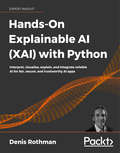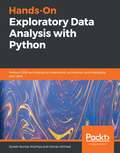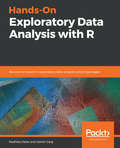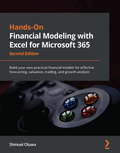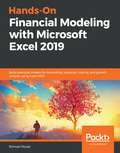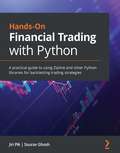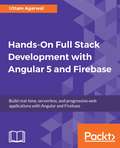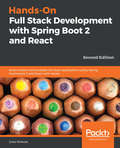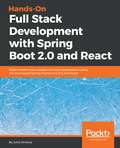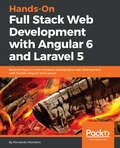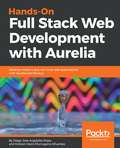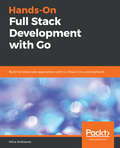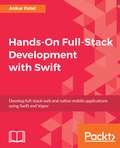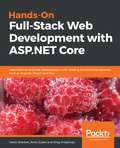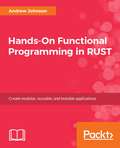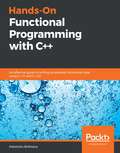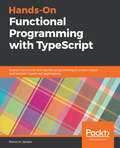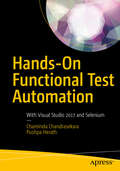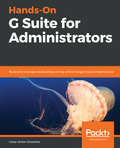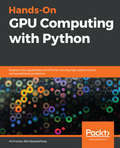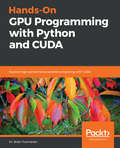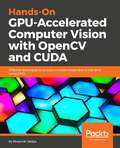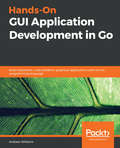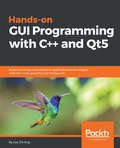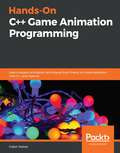- Table View
- List View
Hands-On Explainable AI (XAI) with Python: Interpret, visualize, explain, and integrate reliable AI for fair, secure, and trustworthy AI apps
by Denis RothmanThis book is not an introduction to Python programming or machine learning concepts. You must have some foundational knowledge and/or experience with machine learning libraries such as scikit-learn to make the most out of this book. Some of the potential readers of this book include: • Professionals who already use Python for as data science, machine learning, research, and analysis • Data analysts and data scientists who want an introduction into explainable AI tools and techniques • AI Project managers who must face the contractual and legal obligations of AI Explainability for the acceptance phase of their applications
Hands-On Exploratory Data Analysis with Python: Perform EDA techniques to understand, summarize, and investigate your data
by Suresh Kumar Mukhiya Usman AhmedDiscover techniques to summarize the characteristics of your data using PyPlot, NumPy, SciPy, and pandas Key Features Understand the fundamental concepts of exploratory data analysis using Python Find missing values in your data and identify the correlation between different variables Practice graphical exploratory analysis techniques using Matplotlib and the Seaborn Python package Book Description Exploratory Data Analysis (EDA) is an approach to data analysis that involves the application of diverse techniques to gain insights into a dataset. This book will help you gain practical knowledge of the main pillars of EDA - data cleaning, data preparation, data exploration, and data visualization. You'll start by performing EDA using open source datasets and perform simple to advanced analyses to turn data into meaningful insights. You'll then learn various descriptive statistical techniques to describe the basic characteristics of data and progress to performing EDA on time-series data. As you advance, you'll learn how to implement EDA techniques for model development and evaluation and build predictive models to visualize results. Using Python for data analysis, you'll work with real-world datasets, understand data, summarize its characteristics, and visualize it for business intelligence. By the end of this EDA book, you'll have developed the skills required to carry out a preliminary investigation on any dataset, yield insights into data, present your results with visual aids, and build a model that correctly predicts future outcomes. What you will learn Import, clean, and explore data to perform preliminary analysis using powerful Python packages Identify and transform erroneous data using different data wrangling techniques Explore the use of multiple regression to describe non-linear relationships Discover hypothesis testing and explore techniques of time-series analysis Understand and interpret results obtained from graphical analysis Build, train, and optimize predictive models to estimate results Perform complex EDA techniques on open source datasets Who this book is for This EDA book is for anyone interested in data analysis, especially students, statisticians, data analysts, and data scientists. The practical concepts presented in this book can be applied in various disciplines to enhance decision-making processes with data analysis and synthesis. Fundamental knowledge of Python programming and statistical concepts is all you need to get started with this book.
Hands-On Exploratory Data Analysis with R: Become an expert in exploratory data analysis using R packages
by Harish Garg Radhika DatarLearn exploratory data analysis concepts using powerful R packages to enhance your R data analysis skillsKey FeaturesSpeed up your data analysis projects using powerful R packages and techniquesCreate multiple hands-on data analysis projects using real-world dataDiscover and practice graphical exploratory analysis techniques across domainsBook DescriptionHands-On Exploratory Data Analysis with R will help you build not just a foundation but also expertise in the elementary ways to analyze data. You will learn how to understand your data and summarize its main characteristics. You'll also uncover the structure of your data, and you'll learn graphical and numerical techniques using the R language.This book covers the entire exploratory data analysis (EDA) process—data collection, generating statistics, distribution, and invalidating the hypothesis. As you progress through the book, you will learn how to set up a data analysis environment with tools such as ggplot2, knitr, and R Markdown, using tools such as DOE Scatter Plot and SML2010 for multifactor, optimization, and regression data problems.By the end of this book, you will be able to successfully carry out a preliminary investigation on any dataset, identify hidden insights, and present your results in a business context.What you will learnLearn powerful R techniques to speed up your data analysis projectsImport, clean, and explore data using powerful R packagesPractice graphical exploratory analysis techniquesCreate informative data analysis reports using ggplot2Identify and clean missing and erroneous dataExplore data analysis techniques to analyze multi-factor datasetsWho this book is forHands-On Exploratory Data Analysis with R is for data enthusiasts who want to build a strong foundation for data analysis. If you are a data analyst, data engineer, software engineer, or product manager, this book will sharpen your skills in the complete workflow of exploratory data analysis.
Hands-On Financial Modeling with Excel for Microsoft 365: Build your own practical financial models for effective forecasting, valuation, trading, and growth analysis, 2nd Edition
by Shmuel OluwaExplore a variety of Excel features, functions, and productivity tips for various aspects of financial modelingKey FeaturesExplore Excel's financial functions and pivot tables with this updated second editionBuild an integrated financial model with Excel for Microsoft 365 from scratchPerform financial analysis with the help of real-world use casesBook DescriptionFinancial modeling is a core skill required by anyone who wants to build a career in finance. Hands-On Financial Modeling with Excel for Microsoft 365 explores financial modeling terminologies with the help of Excel.Starting with the key concepts of Excel, such as formulas and functions, this updated second edition will help you to learn all about referencing frameworks and other advanced components for building financial models. As you proceed, you'll explore the advantages of Power Query, learn how to prepare a 3-statement model, inspect your financial projects, build assumptions, and analyze historical data to develop data-driven models and functional growth drivers. Next, you'll learn how to deal with iterations and provide graphical representations of ratios, before covering best practices for effective model testing. Later, you'll discover how to build a model to extract a statement of comprehensive income and financial position, and understand capital budgeting with the help of end-to-end case studies.By the end of this financial modeling Excel book, you'll have examined data from various use cases and have developed the skills you need to build financial models to extract the information required to make informed business decisions.What you will learnIdentify the growth drivers derived from processing historical data in ExcelUse discounted cash flow (DCF) for efficient investment analysisPrepare detailed asset and debt schedule models in ExcelCalculate profitability ratios using various profit parametersObtain and transform data using Power QueryDive into capital budgeting techniquesApply a Monte Carlo simulation to derive key assumptions for your financial modelBuild a financial model by projecting balance sheets and profit and lossWho this book is forThis book is for data professionals, analysts, traders, business owners, and students who want to develop and implement in-demand financial modeling skills in their finance, analysis, trading, and valuation work. Even if you don't have any experience in data and statistics, this book will help you get started with building financial models. Working knowledge of Excel is a prerequisite.
Hands-On Financial Modeling with Microsoft Excel 2019: Build practical models for forecasting, valuation, trading, and growth analysis using Excel 2019
by Shmuel OluwaExplore the aspects of financial modeling with the help of clear and easy-to-follow instructions and a variety of Excel features, functions, and productivity tips Key Features A non data professionals guide to exploring Excel's financial functions and pivot tables Learn to prepare various models for income and cash flow statements, and balance sheets Learn to perform valuations and identify growth drivers with real-world case studies Book Description Financial modeling is a core skill required by anyone who wants to build a career in finance. Hands-On Financial Modeling with Microsoft Excel 2019 examines various definitions and relates them to the key features of financial modeling with the help of Excel. This book will help you understand financial modeling concepts using Excel, and provides you with an overview of the steps you should follow to build an integrated financial model. You will explore the design principles, functions, and techniques of building models in a practical manner. Starting with the key concepts of Excel, such as formulas and functions, you will learn about referencing frameworks and other advanced components of Excel for building financial models. Later chapters will help you understand your financial projects, build assumptions, and analyze historical data to develop data-driven models and functional growth drivers. The book takes an intuitive approach to model testing, along with best practices and practical use cases. By the end of this book, you will have examined the data from various use cases, and you will have the skills you need to build financial models to extract the information required to make informed business decisions. What you will learn Identify the growth drivers derived from processing historical data in Excel Use discounted cash flow (DCF) for efficient investment analysis Build a financial model by projecting balance sheets, profit, and loss Apply a Monte Carlo simulation to derive key assumptions for your financial model Prepare detailed asset and debt schedule models in Excel Discover the latest and advanced features of Excel 2019 Calculate profitability ratios using various profit parameters Who this book is for This book is for data professionals, analysts, traders, business owners, and students, who want to implement and develop a high in-demand skill of financial modeling in their finance, analysis, trading, and valuation work. This book will also help individuals that have and don't have any experience in data and stats, to get started with building financial models. The book assumes working knowledge with Excel.
Hands-On Financial Trading with Python: A practical guide to using Zipline and other Python libraries for backtesting trading strategies
by Sourav Ghosh Jiri PikDiscover how to build and backtest algorithmic trading strategies with ZiplineKey FeaturesGet to grips with market data and stock analysis and visualize data to gain quality insightsFind out how to systematically approach quantitative research and strategy generation/backtesting in algorithmic tradingLearn how to navigate the different features in Python's data analysis librariesBook DescriptionAlgorithmic trading helps you stay ahead of the markets by devising strategies in quantitative analysis to gain profits and cut losses. The book starts by introducing you to algorithmic trading and explaining why Python is the best platform for developing trading strategies. You'll then cover quantitative analysis using Python, and learn how to build algorithmic trading strategies with Zipline using various market data sources. Using Zipline as the backtesting library allows access to complimentary US historical daily market data until 2018. As you advance, you will gain an in-depth understanding of Python libraries such as NumPy and pandas for analyzing financial datasets, and explore Matplotlib, statsmodels, and scikit-learn libraries for advanced analytics. You'll also focus on time series forecasting, covering pmdarima and Facebook Prophet. By the end of this trading book, you will be able to build predictive trading signals, adopt basic and advanced algorithmic trading strategies, and perform portfolio optimization.What you will learnDiscover how quantitative analysis works by covering financial statistics and ARIMAUse core Python libraries to perform quantitative research and strategy development using real datasetsUnderstand how to access financial and economic data in PythonImplement effective data visualization with MatplotlibApply scientific computing and data visualization with popular Python librariesBuild and deploy backtesting algorithmic trading strategiesWho this book is forThis book is for data analysts and financial traders who want to explore how to design algorithmic trading strategies using Python's core libraries. If you are looking for a practical guide to backtesting algorithmic trading strategies and building your own strategies, then this book is for you. Beginner-level working knowledge of Python programming and statistics will be helpful.
Hands-On Full Stack Development with Angular 5 and Firebase: Build real-time, serverless, and progressive web applications with Angular and Firebase
by Uttam AgarwalBuild an end-to-end application from development to production by binding Angular with Firebase in this complete guide to web application development Key Features Build a real-time production-ready web application by leveraging the features of Angular as front end and Firebase as the back end Learn more about authentication, databases, and security with Firebase Learn how to grow your application user base using Google analytics and how to make your application PWA compliant. Book Description This book is a complete package for you to build real-time web applications. You will build an end-to-end social networking web application from development to production with Angular as the frontend and Firebase as the backend. You will create an application called Friends with authentication, friends, and chat features. During the process, you’ll use Firebase authentication to register new users and Firebase database to store your extra user data. You’ll take a look at how to store and retrieve your user's images from Firebase storage. Then, you’ll create a real-time chat module with the Firebase database. Next, you’ll secure your database using Firebase security, make your application live with Firebase hosting, and develop your application with analytics. Moving on, you’ll take a look at how to create web pages using bootstrap with HTML, CSS, and TypeScript. You will use the angularfire2 library API in Angular services to interact with Firebase and write unit tests using the Jasmine framework that will help you to write a production-ready application. You’ll also discover various debugging techniques to troubleshoot any bug in your application. Finally, you’ll make your application Progressive Web Applications compliant. By the end of this book, you’ll be able to confidently build any complex application. What you will learn Understand the core concepts of Angular framework Create web pages with Angular as front end and Firebase as back end Develop a real-time social networking application Make your application live with Firebase hosting Engage your user using Firebase cloud messaging Grow your application with Google analytics Learn about Progressive Web App Who this book is for This book is for JavaScript developers who have some previous knowledge of the Angular framework and want to start developing serverless applications with Angular and Firebase. If you are looking for a more practical and less theory-based approach to learn these concepts, then this book is for you.
Hands-On Full Stack Development with Spring Boot 2 and React: Build modern and scalable full stack applications using Spring Framework 5 and React with Hooks, 2nd Edition
by Juha HinkulaA comprehensive guide to building full stack applications covering frontend and server-side programming, data management, and web securityKey FeaturesUnleash the power of React Hooks to build interactive and complex user interfacesBuild scalable full stack applications designed to meet demands of modern usersUnderstand how the Axios library simplifies CRUD operationsBook DescriptionReact Hooks have changed the way React components are coded. They enable you to write components in a more intuitive way without using classes, which makes your code easier to read and maintain. Building on from the previous edition, this book is updated with React Hooks and the latest changes introduced in create-react-app and Spring Boot 2.1.This book starts with a brief introduction to Spring Boot. You’ll understand how to use dependency injection and work with the data access layer of Spring using Hibernate as the ORM tool. You’ll then learn how to build your own RESTful API endpoints for web applications. As you advance, the book introduces you to other Spring components, such as Spring Security to help you secure the backend. Moving on, you’ll explore React and its app development environment and components for building your frontend. Finally, you’ll create a Docker container for your application by implementing the best practices that underpin professional full stack web development.By the end of this book, you’ll be equipped with all the knowledge you need to build modern full stack applications with Spring Boot for the backend and React for the frontend.What you will learnCreate a RESTful web service with Spring BootGrasp the fundamentals of dependency injection and how to use it for backend developmentDiscover techniques for securing the backend using Spring SecurityUnderstand how to use React for frontend programmingBenefit from the Heroku cloud server by deploying your application to itDelve into the techniques for creating unit tests using JUnitExplore the Material UI component library to make more user-friendly user interfacesWho this book is forIf you are a Java developer familiar with Spring, but are new to building full stack applications, this is the book for you.
Hands-On Full Stack Development with Spring Boot 2.0 and React: Build modern and scalable full stack applications using the Java-based Spring Framework 5.0 and React
by Juha HinkulaDevelop efficient and modern full-stack applications using Spring Boot and React 16Key Features Develop resourceful backends using Spring Boot and faultless frontends using React. Explore the techniques involved in creating a full-stack app by going through a methodical approach. Learn to add CRUD functionalities and use Material UI in the user interface to make it more user-friendly.Book DescriptionApart from knowing how to write frontend and backend code, a full-stack engineer has to tackle all the problems that are encountered in the application development life cycle, starting from a simple idea to UI design, the technical design, and all the way to implementing, testing, production, deployment, and monitoring. This book covers the full set of technologies that you need to know to become a full-stack web developer with Spring Boot for the backend and React for the frontend. This comprehensive guide demonstrates how to build a modern full-stack application in practice. This book will teach you how to build RESTful API endpoints and work with the data access Layer of Spring, using Hibernate as the ORM. As we move ahead, you will be introduced to the other components of Spring, such as Spring Security, which will teach you how to secure the backend. Then, we will move on to the frontend, where you will be introduced to React, a modern JavaScript library for building fast and reliable user interfaces, and its app development environment and components.You will also create a Docker container for your application. Finally, the book will lay out the best practices that underpin professional full-stack web development.What you will learn Create a RESTful web service with Spring Boot Understand how to use React for frontend programming Gain knowledge of how to create unit tests using JUnit Discover the techniques that go into securing the backend using Spring Security Learn how to use Material UI in the user interface to make it more user-friendly Create a React app by using the Create React App starter kit made by FacebookWho this book is forJava developers who are familiar with Spring, but have not yet built full-stack applications
Hands-On Full Stack Web Development with Angular 6 and Laravel 5: Become fluent in both frontend and backend web development with Docker, Angular and Laravel
by Fernando MonteiroBuild modern, fast, and progressive web applications using modern features of PHP 7 and TypeScriptKey FeaturesExplore the latest features of Angular and Laravel to build applications that are powerful, consistent, and maintainableDevelop modern user interfaces with a reusable component-based architecture using Angular 6 and Bootstrap 4Learn how to build secure backend APIs with LaravelBook DescriptionAngular, considered as one of the most popular and powerful frontend frameworks, has undergone a major overhaul to embrace emerging web technologies so that developers can build cutting-edge web applications.This book gives you practical knowledge of building modern full-stack web apps from scratch using Angular with a Laravel Restful back end.The book begins with a thorough introduction to Laravel and Angular and its core concepts like custom errors messages, components, routers, and Angular-cli, with each concept being explained first, and then put into practice in the case-study project.With the basics covered, you will learn how sophisticated UI features can be added using NgBootstrao and a component-based architecture. You will learn to extend and customize variables from Bootstrap CSS framework.You will learn how to create secure web application with Angular and Laravel using token based authentication. Finally, you will learn all about progressive web applications and build and deploy a complete fullstack application using Docker and Docker-compose.By the end of this book, you'll gain a solid understanding of Angular 6 and how it interacts with a Laravel 5.x backendWhat you will learnExplore the core features of Angular 6 to create sophisticated user interfacesUse Laravel 5 to its full extent to create a versatile backend layer based on RESTful APIsConfigure a web application in order to accept user-defined data and persist it into the database using server-side APIsBuild an off-line-first application using service-worker and manifest fileDeal with token based authentication on single page application (SPA).Secure your application against threats and vulnerabilities in a time efficient wayDeploy using Docker and Docker-composeWho this book is forThis book targets developers who are new to Angular, Laravel, or both, and are seeking a practical, best-practice approach to development with these technologies. They must have some knowledge of HTML, CSS and JavaScript. Familiarity of PHP is assumed to get the most from this book.
Hands-On Full Stack Web Development with Aurelia: Develop modern and real-time web applications with Aurelia and Node.js
by Diego Argüelles Rojas Erikson MurrugarraDevelop rich and scalable web applications with Node.js, Express.js, and MongoDBKey Features Learn the advanced features of Aurelia to build responsive web applicationsWrite clean, modular, and testable code that will be easy to maintain and evolveHarness the power of JavaScript on the client and server side to build full-stack applicationsBook DescriptionHands-On Full Stack Web Development with Aurelia begins with a review of basic JavaScript concepts and the structure of an Aurelia application generated with the Aurelia-CLI tool. You will learn how to create interesting and intuitive application using the Aurelia-Materialize plugin, which implements the material design approach. Once you fully configure a FIFA World Cup 2018 app, you'll start creating the initial components through TDD practices and then develop backend services to process and store all the user data.This book lets you explore the NoSQL model and implement it using one of the most popular NoSQL databases, MongoDB, with some exciting libraries to make the experience effortless. You'll also be able to add some advanced behavior to your components, from managing the lifecycle properly to using dynamic binding, field validations, and the custom service layer.You will integrate your application with Google OAuth Service and learn best practices to secure your applications. Furthermore, you'll write UI Testing scripts to create high-quality Aurelia Apps and explore the most used tools to run end-to-end tests. In the concluding chapters, you'll be able to deploy your application to the Cloud and Docker containers.By the end of this book, you will have learned how to create rich applications using best practices and modern approaches.What you will learnEmploy best practices and modern approaches to create frontend applicationsLearn about modern CSS preprocessors and improve the readability of your applicationUse the Aurelia framework to create navigable web applicationsWrite your own tests, making your application secure and fault-tolerantCreate solid RESTful APIs using the microservice architectureUnderstand the NoSQL paradigm and get the best performance from your databaseIntegrate third-party libraries such as Gmail for Single Sign OnWrite UI testing scripts and integration tests to build extensible appsWho this book is forHands-On Full Stack Web Development with Aurelia is for you if you are a web or full-stack JavaScript developer who has experience with traditional stacks such as LAMP, MEAN, or MERN and wish to explore the power of Aurelia and new stack with modern web technologies.
Hands-On Full-Stack Development with Go: Build full stack web applications with Go, React, Gin, and GopherJS
by Mina AndrawosThe book will appeal to Go developers who are looking to start building full-stack web applications in Go
Hands-On Full-Stack Development with Swift: Develop full-stack web and native mobile applications using Swift and Vapor
by Ankur PatelBuild full-stack shopping list applications from scratch for web and mobile platforms using Xcode, Vapor, and SwiftKey FeaturesBuild, package, and deploy an end-to-end app solution for mobile and web with Swift 4Increase developer productivity by creating reusable client and server componentsDevelop backend services for your apps and websites using Vapor frameworkBook DescriptionMaking Swift an open-source language enabled it to share code between a native app and a server. Building a scalable and secure server backend opens up new possibilities, such as building an entire application written in one language—Swift.This book gives you a detailed walk-through of tasks such as developing a native shopping list app with Swift and creating a full-stack backend using Vapor (which serves as an API server for the mobile app). You'll also discover how to build a web server to support dynamic web pages in browsers, thereby creating a rich application experience.You’ll begin by planning and then building a native iOS app using Swift. Then, you'll get to grips with building web pages and creating web views of your native app using Vapor. To put things into perspective, you'll learn how to build an entire full-stack web application and an API server for your native mobile app, followed by learning how to deploy the app to the cloud, and add registration and authentication to it.Once you get acquainted with creating applications, you'll build a tvOS version of the shopping list app and explore how easy is it to create an app for a different platform with maximum code shareability. Towards the end, you’ll also learn how to create an entire app for different platforms in Swift, thus enhancing your productivity.What you will learnGet accustomed to server-side programming as well as the Vapor frameworkLearn how to build a RESTful APIMake network requests from your app and handle error states when a network request failsDeploy your app to Heroku using the CLI commandWrite a test for the Vapor backendCreate a tvOS version of your shopping list app and explore code-sharing with an iOS platformAdd registration and authentication so that users can have their own shopping listsWho this book is forThis book is for developers who are looking to build full-stack web and native mobile applications using Swift. An understanding of HTML, CSS, and JavaScript would be beneficial when building server-rendered pages with Vapor.
Hands-On Full-Stack Web Development with ASP.NET Core: Learn end-to-end web development with leading frontend frameworks, such as Angular, React, and Vue
by Tamir Dresher Amir Zuker Shay FriedmanBecome a full-stack developer by learning popular Microsoft technologies and platforms such as .NET Core, ASP.NET Core, Entity Framework, and AzureKey FeaturesBring static typing to web development with features compatible in TypeScript 3Implement a slim marketplace single page application (SPA) in Angular, React, and VueModernize your web apps with Microsoft Azure, Visual Studio, and GitBook DescriptionToday, full-stack development is the name of the game. Developers who can build complete solutions, including both backend and frontend products, are in great demand in the industry, hence being able to do so a desirable skill. However, embarking on the path to becoming a modern full-stack developer can be overwhelmingly difficult, so the key purpose of this book is to simplify and ease the process.This comprehensive guide will take you through the journey of becoming a full-stack developer in the realm of the web and .NET. It begins by implementing data-oriented RESTful APIs, leveraging ASP.NET Core and Entity Framework. Afterward, it describes the web development field, including its history and future horizons. Then, you’ll build webbased Single-Page Applications (SPAs) by learning about numerous popular technologies, namely TypeScript, Angular, React, and Vue. After that, you’ll learn about additional related concerns involving deployment, hosting, and monitoring by leveraging the cloud; specifically, Azure. By the end of this book, you’ll be able to build, deploy, and monitor cloud-based, data-oriented, RESTful APIs, as well as modern web apps, using the most popular frameworks and technologies.What you will learnBuild RESTful APIs in C# with ASP.NET Core, web APIs, and Entity FrameworkSee the history and future horizons of the web development fieldBring static-typing to web apps using TypeScriptBuild web applications using Angular, React, and VueDeploy your application to the cloudWrite web applications that scale, can adapt to changes, and are easy to maintainDiscover best practices and real-world tips and tricksSecure your backend server with Authentication and Authorization using OAuth 2.0Who this book is forThis book is for developers who are keen on strengthening their skills in the field of cloud-based full-stack web development. You need basic knowledge of web-related pillars, including HTML, CSS, and JavaScript, as well as C# and REST.This book targets novice developers in the realm of Web development and ASP.NET who desire to advance to modern Web and ASP.NET Core development and leverage the Cloud to manage and bring everything together.
Hands-On Functional Programming in Rust: Build modular and reactive applications with functional programming techniques in Rust 2018
by Andrew JohnsonExplore the support Rust offers for creating functional applications in Rust. Learn about various design patterns, implementing concurrency, metaprogramming, and so on in the processKey FeaturesLearn generics, organization, and design patterns in functional programmingModularize your applications and make them highly reusable and testable using functional design patternsGet familiar with complex concepts such as metaprogramming, concurrency, and immutabilityBook DescriptionFunctional programming allows developers to divide programs into smaller, reusable components that ease the creation, testing, and maintenance of software as a whole. Combined with the power of Rust, you can develop robust and scalable applications that fulfill modern day software requirements. This book will help you discover all the Rust features that can be used to build software in a functional way.We begin with a brief comparison of the functional and object-oriented approach to different problems and patterns. We then quickly look at the patterns of control flow, data the abstractions of these unique to functional programming. The next part covers how to create functional apps in Rust; mutability and ownership, which are exclusive to Rust, are also discussed. Pure functions are examined next and you'll master closures, their various types, and currying. We also look at implementing concurrency through functional design principles and metaprogramming using macros. Finally, we look at best practices for debugging and optimization. By the end of the book, you will be familiar with the functional approach of programming and will be able to use these techniques on a daily basis.What you will learnHow Rust supports the use of basic functional programming principlesUse functional programming to handle concurrency with eleganceRead and interpret complex type signatures for types and functionsImplement powerful abstractions using meta programming in RustCreate quality code formulaically using Rust's functional design patternsMaster Rust's complex ownership mechanisms particularly for mutabilityWho this book is forThis book is for Rust developers who are comfortable with the language and now want to improve their coding abilities by learning advanced functional techniques to enhance their skillset and create robust and testable apps.
Hands-On Functional Programming with C++: An effective guide to writing accelerated functional code using C++17 and C++20
by Alexandru Bolboaca<p>Learn functional programming and build robust applications using the latest functional features in C++ <p>Key Features: <p> <li>Learn programming concepts such as loops, expressive code, and simple parallelization <li>Understand the working of Lambdas and Currying and write Pure functions <li>Explore event sourcing and other functional patterns to improve the efficiency of your applications</li> <p>Functional programming enables you to divide your software into smaller, reusable components that are easy to write, debug, and maintain. Combined with the power of C++, you can develop scalable and functional applications for modern software requirements. This book will help you discover the functional features in C++ 17 and C++ 20 to build enterprise-level applications. <p>Starting with the fundamental building blocks of functional programming and how to use them in C++, you'll explore functions, currying, and lambdas. As you advance, you'll learn how to improve cohesion and delve into test-driven development, which will enable you in designing better software. In addition to this, the book covers architectural patterns such as event sourcing to help you get to grips with the importance of immutability for data storage. You'll even understand how to “think in functions” and implement design patterns in a functional way. <p>By the end of this book, you'll be able to write faster and cleaner production code in C++ with the help of functional programming. <p>What you will learn: <p> <li>Understand the fundamentals of functional programming <li>Structure your code by understanding the building blocks of functional programming <li>Compare design styles in functional programming and object-oriented programming (OOP) <li>Use the concept of currying to create new functions in C++ <li>Become skilled at implementing design patterns in a functional way <li>Get to grips with multithreading by means of functional programming <li>Learn how to improve memory consumption when using functional constructs </li> <p>Who this book is for: This book is for C++ developers who want to learn functional programming but have little to no knowledge of the paradigm. Although no prior knowledge of functional programming is necessary, basic C++ programming experience will help you understand key concepts covered in the book.</p>
Hands-On Functional Programming with Typescript: Explore functional and reactive programming to create robust and testable TypeScript applications
by Remo H. JansenThis book is designed for readers without previous experience in functional programming with JavaScript, TypeScript or any other programming language. The reader must have some previous experience with TypeScript and web development. No previous knowledge about functional programming is required.
Hands-On Functional Test Automation: With Visual Studio 2017 and Selenium
by Chaminda Chandrasekara Pushpa HerathGet started with functional testing of both web apps and Windows apps using different test frameworks. This book will take you on a deep dive into integrating functional automation testing with deployment pipelines.Hands-On Functional Test Automation contains step-by-step lessons that will give you an understanding of how to do functional test automation using Selenium with C# and Python. Also, you will learn how to enhance your test automation development with third-party frameworks. You will configure test clients, run functional tests through Azure DevOps release management, and carry out performance and load-testing to gain a good understanding of how to do cloud-based load testing.Each lesson comprises an introduction to the related concepts to help you understand how things work. This will broaden your knowledge so you can implement test automation in the correct way. At the end of each lesson alternative options and other enhancement possibilities are discussed to allow you to do further exploration. You will:· Implement functional test automation of Windows and web applications· Use Visual Studio for load and performance testing · Configure and run cloud-based load testing· Integrate testing with deployment pipelines
Hands-On G Suite for Administrators: Build and manage any business on top of the Google Cloud infrastructure
by Cesar Anton DorantesEffectively implement and administer business solutions on any scale in a cost-effective way to have a competitive advantage using Gsuite Key Features Enhance administration with Admin console and Google Apps Script Prepare for the G suite certification using the concepts in the book Learn how to use reports to monitor, troubleshoot and optimize G Suite Book Description Hands-On G Suite for Administrators is a comprehensive hands-on guide to G Suite Administration that will prepare you with all you need to know to become a certified G Suite Administrator, ready to handle all the business scales, from a small office to a large enterprise. You will start by learning the main features, tools, and services from G Suite for Business and then, you will explore all it has to offer and the best practices, so you can make the most out of it. We will explore G Suite tools in depth so you and your team get everything you need -combination of tools, settings and practices- to succeed in an intuitive, safe and collaborative way. While learning G Suite tools you will also learn how to use Google Sites and App Maker, to create from your corporate site to internal tools, live reports that seamlessly integrate with live documents, and advanced Google Services. Finally, you will learn how to set up, analyze and enforce Security, Privacy for your business and how to efficiently troubleshoot a wide variety of issues. What you will learn Setting up G Suite for the business account Work with the advanced setup of additional business domains and administrate users in multiple Explore Guite's extensive set of features to cover your team's creation and collaboration needs Setup, manage and analyze your security to prevent, find or fix any security problem in G Suite Manage Mobile devices and integrate with third-party apps Create cloud documents, working alone or collaborating in real time Who this book is for System administrators, cloud administrators, business professionals, and aspirants of G Suite admin certificate wanting to master implementing G Suite tools for various admin tasks and effectively implement the G Suite administration for business
Hands-On GPU Computing with Python: Explore the capabilities of GPUs for solving high performance computational problems
by Avimanyu BandyopadhyayExplore GPU-enabled programmable environment for machine learning, scientific applications, and gaming using PuCUDA, PyOpenGL, and Anaconda AccelerateKey FeaturesUnderstand effective synchronization strategies for faster processing using GPUsWrite parallel processing scripts with PyCuda and PyOpenCLLearn to use the CUDA libraries like CuDNN for deep learning on GPUsBook DescriptionGPUs are proving to be excellent general purpose-parallel computing solutions for high performance tasks such as deep learning and scientific computing.This book will be your guide to getting started with GPU computing. It will start with introducing GPU computing and explain the architecture and programming models for GPUs. You will learn, by example, how to perform GPU programming with Python, and you’ll look at using integrations such as PyCUDA, PyOpenCL, CuPy and Numba with Anaconda for various tasks such as machine learning and data mining. Going further, you will get to grips with GPU work flows, management, and deployment using modern containerization solutions. Toward the end of the book, you will get familiar with the principles of distributed computing for training machine learning models and enhancing efficiency and performance.By the end of this book, you will be able to set up a GPU ecosystem for running complex applications and data models that demand great processing capabilities, and be able to efficiently manage memory to compute your application effectively and quickly.What you will learnUtilize Python libraries and frameworks for GPU accelerationSet up a GPU-enabled programmable machine learning environment on your system with AnacondaDeploy your machine learning system on cloud containers with illustrated examplesExplore PyCUDA and PyOpenCL and compare them with platforms such as CUDA, OpenCL and ROCm.Perform data mining tasks with machine learning models on GPUsExtend your knowledge of GPU computing in scientific applicationsWho this book is forData Scientist, Machine Learning enthusiasts and professionals who wants to get started with GPU computation and perform the complex tasks with low-latency. Intermediate knowledge of Python programming is assumed.
Hands-On GPU Programming with Python and CUDA: Explore High-performance Parallel Computing With Cuda
by Brian TuomanenThis book is for Python developers who want to learn effective GPU programming with CUDA to achieve high performance and boost the productivity of applications. The readers should have an understanding of basic mathematical concepts necessary and an introductory background about any C-based programming language (C, C++, Java, C#, and so forth.)
Hands-On GPU-Accelerated Computer Vision with OpenCV and CUDA: Effective techniques for processing complex image data in real time using GPUs
by Bhaumik VaidyaDiscover how CUDA allows OpenCV to handle complex and rapidly growing image data processing in computer and machine vision by accessing the power of GPUKey FeaturesExplore examples to leverage the GPU processing power with OpenCV and CUDAEnhance the performance of algorithms on embedded hardware platformsDiscover C++ and Python libraries for GPU accelerationBook DescriptionComputer vision has been revolutionizing a wide range of industries, and OpenCV is the most widely chosen tool for computer vision with its ability to work in multiple programming languages. Nowadays, in computer vision, there is a need to process large images in real time, which is difficult to handle for OpenCV on its own. This is where CUDA comes into the picture, allowing OpenCV to leverage powerful NVDIA GPUs. This book provides a detailed overview of integrating OpenCV with CUDA for practical applications. To start with, you’ll understand GPU programming with CUDA, an essential aspect for computer vision developers who have never worked with GPUs. You’ll then move on to exploring OpenCV acceleration with GPUs and CUDA by walking through some practical examples.Once you have got to grips with the core concepts, you’ll familiarize yourself with deploying OpenCV applications on NVIDIA Jetson TX1, which is popular for computer vision and deep learning applications. The last chapters of the book explain PyCUDA, a Python library that leverages the power of CUDA and GPUs for accelerations and can be used by computer vision developers who use OpenCV with Python.By the end of this book, you’ll have enhanced computer vision applications with the help of this book's hands-on approach.What you will learnUnderstand how to access GPU device properties and capabilities from CUDA programsLearn how to accelerate searching and sorting algorithmsDetect shapes such as lines and circles in imagesExplore object tracking and detection with algorithmsProcess videos using different video analysis techniques in Jetson TX1Access GPU device properties from the PyCUDA programUnderstand how kernel execution worksWho this book is forThis book is a go-to guide for you if you are a developer working with OpenCV and want to learn how to process more complex image data by exploiting GPU processing. A thorough understanding of computer vision concepts and programming languages such as C++ or Python is expected.
Hands-On GUI Application Development in Go: Build Responsive, Cross-platform, Graphical Applications With The Go Programming Language
by Andrew WilliamsGo Developers who want to build beautiful GUI applications in Go
Hands-On GUI Programming with C++ and Qt5: Build stunning cross-platform applications and widgets with the most powerful GUI framework
by Lee Zhi EngCreate visually appealing and feature-rich applications by using Qt 5 and the C++ languageKey FeaturesExplore Qt 5’s powerful features to easily design your GUI applicationLeverage Qt 5 to build attractive cross-platform applicationsWork with Qt modules for multimedia, networking, and location, to customize your Qt applicationsBook DescriptionQt 5, the latest version of Qt, enables you to develop applications with complex user interfaces for multiple targets. It provides you with faster and smarter ways to create modern UIs and applications for multiple platforms. This book will teach you to design and build graphical user interfaces that are functional, appealing, and user-friendly.In the initial part of the book, you will learn what Qt 5 is and what you can do with it. You will explore the Qt Designer, discover the different types of widgets generally used in Qt 5, and then connect your application to the database to perform dynamic operations. Next, you will be introduced to Qt 5 chart which allows you to easily render different types of graphs and charts and incorporate List View Widgets in your application. You will also work with various Qt modules, like QtLocation, QtWebEngine, and the networking module through the course of the book. Finally, we will focus on cross-platform development with QT 5 that enables you to code once and run it everywhere, including mobile platforms. By the end of this book, you will have successfully learned about high-end GUI applications and will be capable of building many more powerful, cross-platform applications.What you will learnImplement tools provided by Qt 5 to design a beautiful GUIUnderstand different types of graphs and charts supported by Qt 5Create a web browser using the Qt 5 WebEngine module and web view widgetConnect to the MySQL database and display data obtained from it onto the Qt 5 GUIIncorporate the Qt 5 multimedia and networking module in your applicationDevelop Google Map-like applications using Qt 5’s location moduleDiscover cross-platform development by exporting the Qt 5 application to different platformsUncover the secrets behind debugging Qt 5 and C++ applicationsWho this book is forThis book will appeal to developers and programmers who would like to build GUI-based applications. Basic knowledge of C++ is necessary and the basics of Qt would be helpful.
Hands-On Game Animation Programming: Learn Modern Animation Techniques From Theory To Implementation With C++ And Opengl
by Gabor SzauerThis book is for professional, independent, and hobbyist developers interested in building a robust animation system from the ground up. Some knowledge of the C++ programming language will be helpful.
